If you’re in the technology industry like I am, you know how challenging it can be to stay up-to-date in our fast-changing niche.
Even the word technology has a different meaning today than it did a few years ago. It’s no longer just about our gadgets and computers. These days, technology touches almost every aspect of our lives.
This is most obvious to me when I think about how the combination of information technology (IT) and communications technology (CT) is transforming our business today.
I’ve read several tech blogs about ICT recently, and it’s fascinating tech. But I’m the first to admit it’s complex.
This new ICT (convergence of IT and CT) doesn’t just relate to the technologies themselves like cloud computing, big data, software defined networks, IoT and mobile broadband. It’s also an open platform and ecosystem where developers can benefit by building their innovations using these technologies.
There are so many individual parts that work together to form the whole.
So why should you care about new ICT?
Because cutting-edge ICT is affecting you right now. And it will continue to make your life easier, safer and better in the future.
It has the potential to change your life as a marketer, a techie, a parent and an inhabitant on planet earth.
Simply put, ICT tech will help us smoothly transition into the new digital era. In this article, I will demystify ICT — and explain how it’s about to rock your world.
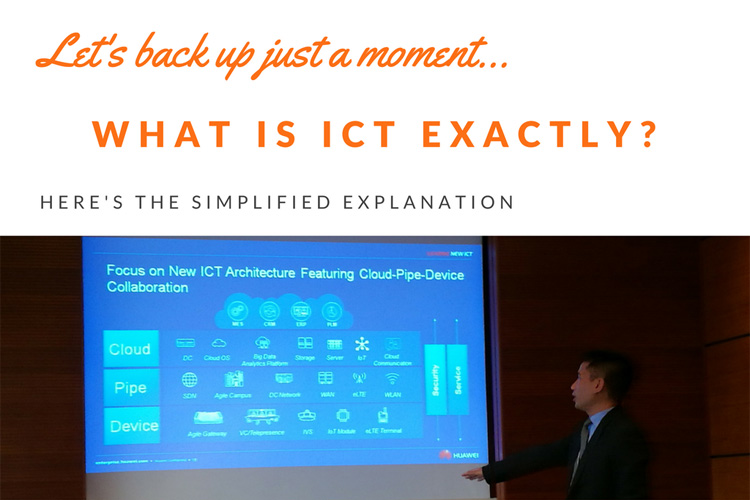
You know what IT is — it’s information technology.
The “C” adds a layer of communication. ICT is information and communications technology.
ICT is usually talked about in the context of how it relates to a specific industry.
For example, you may have heard that ICT tech helps create safer cities by facilitating better communication between multiple entities. (ie. ambulance, fire department, police departments and city officials)
Why haven’t you heard more about this tech until now? You probably have — you just didn’t realize it.
Let me explain.
Let’s pretend it’s year 1870. Your main mode of transportation is a horse.

If someone told you about a Tesla back then, would you get excited?
Probably not — because you wouldn’t realize the impact it would have on your life.
On the other hand, if you could test drive a Tesla back in 1870, you’d surely get excited about it!
It’s the same with leading new ICT tech.
I’m hoping in this article, I can help you touch and feel this tech. I’ll show you how it will dramatically impact your life in the near future.
I’ll give you a simplified version of how it works — and dissect how the pieces fit together.
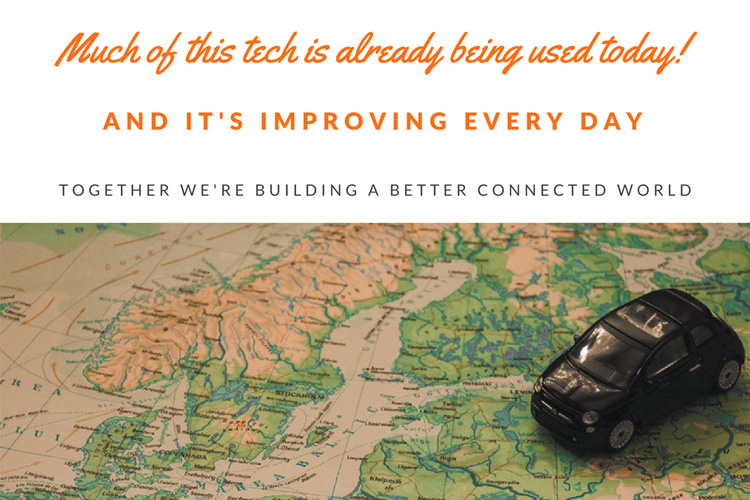
I’d like to take you on a journey to 2020.
What will life be like then?
Let’s look at a few predictions to form a mental image.
- By year 2020, there will be one billion entrepreneurs in the world. (Funders and Founders)
- By year 2020, there will be more robots. These robots will be therapists, companions, assistants and even friends. (Ariane Van de Ven, Global Trends Expert at Telefonica I+D)
- By year 2020, machines displace most of the human job market. (Blaise Aguera y Arcas, Engineer at Microsoft)
- By year 2025, there will be more than 100 billion web-connected devices. (Huawei Technologies)
- By year 2025, IoT will have evolved to the point that all the “things” around us will be able to communicate with each other and make decisions together. (my own prediction)
What does all this mean?
Things are about to get even more exciting in the world of tech.
Let’s talk logistics.
With that many entrepreneurs in the world, soon it won’t be about the connected devices that make our work easier.
Instead, the lines between work time and off time will become even more blurred. It will all just become “life” time.
We’ll want a better connected world so we can reach anyone, anytime — instantly.
Communication, mobility, speed and safety will all become even higher priorities than they are today.
We’ll rely even more on tech for our own personal economies as well as the economies of nations.
Now let’s travel back to 2016.
Do you think that laggy Internet connection is going to cut it when we have 100 billion devices connected?
Will you continue to joyfully wait patiently while your videos buffer on your mobile device?
Of course not. That’s where new ICT tech comes in.
ICT is the foundation that will allow us to transition into a new era. It’s the nuts and bolts that will make the futuristic lives we dream about a reality.
This transition is as significant as moving from horses to self-driving cars.
It has started to and will continue to dramatically change enterprise innovation as we transition into the next digital era.
So what’s involved to make this a seamless digital transformation?
There are 4 cornerstones to ICT. They all work together to make it possible.
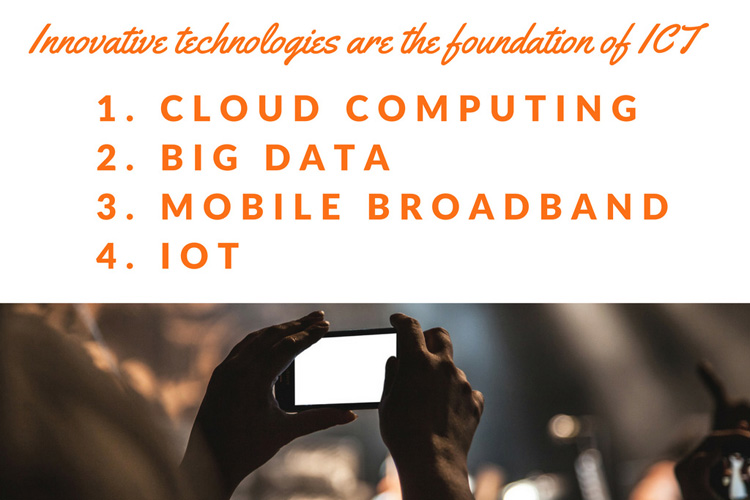
Let’s break down each of these 4 criteria into bite-sized chunks with relevant context.
1. Advances in Cloud Computing
Let’s go back to our highway example.
Imagine every connected device is like a car on the highway. By year 2025, there will be 100 billion cars on that highway.
Where will they all park?
That’s where advances in cloud computing come in. They’ll all park in the cloud of course!
The cloud needs to be ultra-flexible. Everything needs to fit comfortably in the cloud for us to connect and work together efficiently, collaboratively and remotely.
New cloud-based ICT is currently a viable solution for many organizations. Imagine what it would be like to move all your product development into the cloud.
Your team members and partners would be able to seamlessly collaborate regardless of their physical location.
This would pave the way for real-time feedback, innovation and success even for small businesses and startups on a tight budget.
I’d like to give you an example of how cloud computing impacts the TV industry in the omnimedia era.
In China, TV station SZMG deployed a hybrid omnimedia cloud infrastructure.
In this scenario, they implemented a public cloud (outside the TV station) with low-bit-rate editing capabilities and a private cloud (within the TV station) that offered high-definition and 6 layers video editing capabilities.
The synergy between the public and private clouds significantly optimizes the content production process, which supports the omnimedia transformation of traditional broadcast media.
This platform allows SZMG to focus on enhancing their main capabilities including content ingestion, processing, production, management and distribution.
It also helps in other areas such as intelligent sensing, dispatching, collaboration, and security guarantee capabilities.
Now, SZMG can easily introduce new TV channels and programs since the rollout speed has been shortened significantly.
This improves the TV station’s speed of responding and reporting major events, which makes their audiences happy.
2. Big Data (and Analytics)
We’ve all heard the phrase, “Knowledge is power.”
Technically that’s not true, right?
It’s the use of knowledge that’s power. Knowledge is only valuable when it has practical applications.
This relates to big data, and how it’s used.
What is big data? It’s a term used when an entity (organization, enterprise, city, nation, etc.) can’t use traditional methods to process and interpret data anymore.
You can have all the data in the world, but if you can’t interpret it, it’s not useful.
When this happens, new solutions are needed to process that data to make it useful and valuable again.
Think about the incredible amount of data that is being captured now. With 100 billion web-connected devices in 2025, the amount of data captured will become mind-bogglingly gigantic!
Big data, in terms of innovation, involves finding new ways to make sense of all that data.
Think of it this way… You are a cute little garden snake. Right now, you can chomp on the data to organize and process it.
In the future, that data will be the size of a golf ball, and you won’t be able to fit your mouth around it anymore.
But, what if you could interpret and organize that big data in an effective way that makes it easy to digest?
Think of all the information you could gather!
Businesses of all sizes have been drooling over the idea of big data analytics for a long time.
This info could take the guesswork out of many marketing, operations and production decisions.
As an enterprise, you could become more data-driven — which leads to faster, smarter decisions.
With this type of analysis, you’d be able to:
- Identify trends in the market
- Pinpoint info about your customers and their needs
- Find relevant solutions faster and more reliably
- See correlations you didn’t notice before
- Spot problems before they happen
- Etc.
What are the drivers of big data? There are many — and one of the biggest is social media.
For example, there are about 6,000 tweets sent every second.
Many of them contain data that would be useful to retailers, startups, big businesses, small businesses, marketers in every niche, etc.
You can visualize the tweets sent today at Twitter Usage Statistics.
A good example to illustrate the use of big data is in the banking industry.
For any bank-issued credit cards, credit checks are mandatory. In addition to showing credit-worthiness, big data highlights the customer’s payment behavior and the likelihood of him or her defaulting on a loan.
In China, the PBOC (People’s Bank of China) credit system also includes data from other sources, including carriers and utility companies, to show the payment behavior of the customer.
This helps the bank to properly qualify each individual customer.
China Merchants Bank uses a new data platform to bring this data from other sources together. This enables the bank to conduct deep analytics to determine a credit rating or score.
Doing this gives China Merchants Bank 2 immediate advantages:
- Credit checks can be done fast and online. Instead of taking weeks, the process can be done in only a few minutes. This means banks can issue credit cards without the customers having to go to any physical branch.
- It improves the overall customer experience and convenience. This makes the process more attractive to today’s busy and highly mobile individuals.
3. Mobile Broadband
I’ve written about mobile broadband before (like 4G and 5G), and I get a pep in my step every time I think about it.
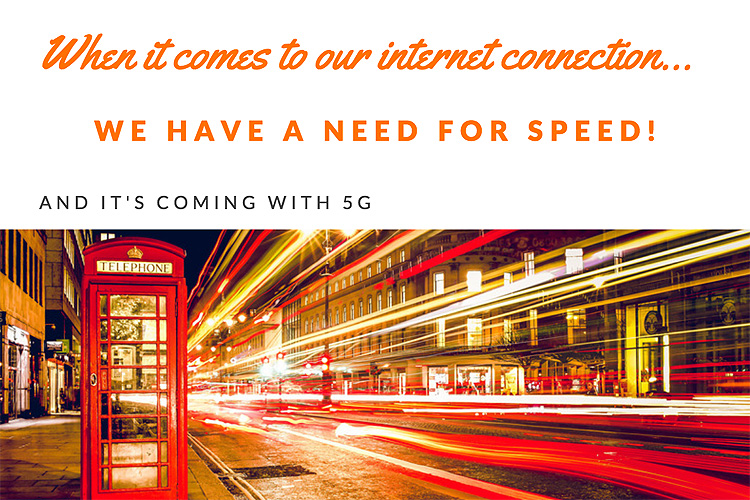
Mobile broadband not only changes our mode of communication, but also our entire way of doing business.
For example, in China, eLTE helps the Shuohuang Railway trains (carrying 350 million tons of coal) by increasing the transport capacity.
This wireless broadband system guarantees the communication between the master and slave locomotives located at both ends of trains, which could be up to 2,500 meters apart.
The eLTE network also enhances operational and maintenance efficiency with trunking dispatching, remote data acquisition, wireless video surveillance, data transmission and other services.
It is the world’s first LTE network for heavy-haul railways. It allows them to continue to expand transfer capacity from 200 million to over 350 million tons of coal (leading to an increase of USD900 million in annual profits).
4. Advances in IoT
The concept of IoT isn’t new. It’s been around for several years. I remember reading Shelly Kramer’s articles about it back in 2009. Shelly was ahead of her time back then, and I remember feeling the excitement ooze out of her blog posts.
When I visited the Huawei HQ recently (read the post about my visit here), I got to spend some time with Tom Goodwin. He was visiting at the same time.
He explained to me that he prematurely invested in making his home “smart.” The tech still isn’t available to make all the pieces work together like they should.
I can appreciate that. I’m still marveled by the fact that someday soon my self-driving car will pull into my garage and then tell my house to turn on the lights.
But like Tom said, the tech isn’t quite developed enough to integrate IoT flawlessly into our lives yet. Sure, some “things” play well together, but the standardization across the board isn’t there.
The good news is, IoT tech is advancing fast. With 100 billion web-connected devices predicted in year 2025 — there’s no debating it’s a critical part of the new ICT formula.
To me, the magic of IoT lies within the communication between devices. Think of it as an entirely new language. The sum of the pieces working together are much greater than the individual parts.
As IoT tech evolves, many bloggers say the focus will become less on the “things” and more on what those things can do (the service). I agree this seems like a natural progression as we transition into this new ICT era.
Our physical world and the computing world will mesh into one efficient ecosystem. Each “thing” will become an important cog in the wheel to make our lives better.
Let’s look at an example of how IoT transformed the business of utility.
In a smart metering’s project in Nigeria, the electricity company (IKEDC) deployed a bi-directional broadband PLC to optimize its grid network.
This helped IKEDC reduce line loss from 46% to 11%. In addition, the utility company gained much needed insight into the reasons for the daily line loss.
6 months after the completion of the project, IKEDC’s income increased significantly, allowing it to upgrade its facilities to meet their citizens’ demands.
The percentage of uncollected bills dropped from 53.3% to 9.2% with better visibility and clamping down on electricity theft and usage from unregistered users.
And speaking of ICT tech making our lives better, there’s another important aspect.

When considering this digital transformation through ICT, it’s important to think globally.
If developed countries move ahead with the advances in ICT, while leaving less developed countries behind, it could create an even larger economic gap around the world.
If you’d like to see how your country ranks in comparison to others, you can download the 2016 Global Connectivity Index (based on research by Huawei). It ranks 50 nations based on their progress along the journey towards digital transformation.
Let’s look at some ways leading new ICT will affect your life and business.
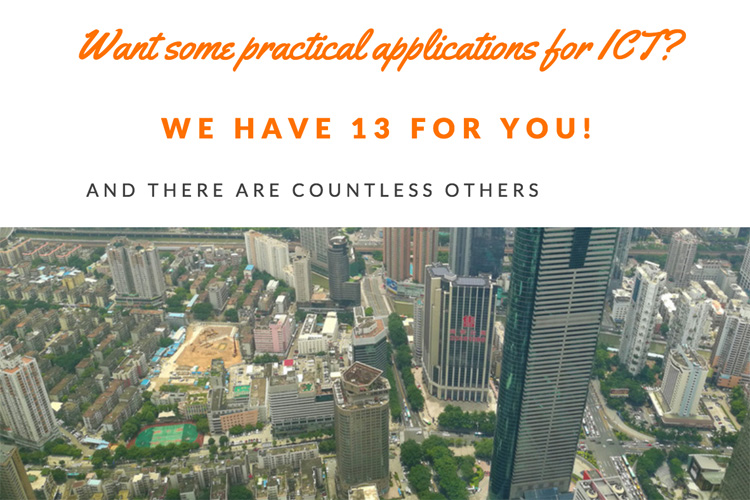
1. Our favorite brands will use big data analytics to offer us products and services that are even more tailored to our needs than today.
Your personal tech will know what you want or need before you realize you want or need it. The solutions you’re looking for will just seem to magically present themselves to you.
2. Local governments can (and are) building safer cities. New ICT tech greatly improves the communication between public services. According to Huawei, “Cities today need effective public safety solutions for incident prevention, emergency response, and evidence collection.”
One problem with the old system was duplicate investments and silo systems since data often couldn’t be shared amongst public service entities. New ICT solved this problem.
3. Through high-speed mobile networks (like 5G), education and knowledge will be available anywhere, anytime, for anyone.
4. As a marketer, you’ll use new ICT to reach customers and potential customers anywhere in the world faster and more effectively than today.
5. Using big data and cloud computing, banks will continue to tailor financial services to fit your specific needs. As you read in the example above, banks will be able to even further customize solutions for you.
6. With converged command and cloud video analysis, criminals will be found and deterred faster than ever before. There will be no place for them to hide.
7. Leading new ICT tech will allow enterprises to achieve efficiency, agility and speed while at the same time, lowering costs to drive opportunities and growth.
8. Through monitoring and management, ICT tech will be used to help protect our natural resources and create more sustainable agriculture. This of course leads to securing more food for the planet.
9. Emerging IoT tech and open cloud platforms can be used to develop, grow and maintain reliable energy. Imagine distributing electricity to anyone, anywhere at anytime.
10. ICT will help with much-needed upgrades in the medical industry. Robot-assisted surgeries are already becoming more popular.
According to the Mayo Clinic, these surgeries provide better precision, smaller incisions, less pain, decreased blood loss and faster healing time.
11. With big data analytics, doctors and other healthcare professionals will have more data to help them make better decisions. It’s likely that big data analytics will be used to determine the cause of cancer — and prevention methods.
12. Enterprise businesses will become more agile and able to respond quickly to change. It will be easier to perform like a fast, lean startup than a slow-moving giant.
13. I saved the best for last… TIME. With leading new ICT comes more time for us. We’ll spend less time driving, waiting, fixing, shopping and all the other things that suck up our time each day. What will we do with all that extra time?

So how do you get started with new ICT?
The first step is to do your homework before choosing a vendor.
Most service providers are IT-based without the communications aspect. In other words, most focus on storage or networking for example.
Instead, choose a vendor with a complete solutions portfolio (full ICT integration).
That way, not only will you be able to get a solution that includes all the areas we talked about, you’ll also be able to work with one vendor that does it all (instead of multiple vendors).
Next, be sure to choose a vendor with an open platform. You want an open ICT infrastructure to build your applications.
And my last piece of advice is to choose a vendor that will innovate along with you. Let the vendor focus on the ICT innovation for your industry so you can focus on the industrial application for your business.
I recommend you read these ICT case studies on the Huawei website to get a feel for why this type of sustainable partnership is a win-win.
Final Thoughts
As you can tell, ICT tech is a topic I’m passionate about. When I was a little girl, I used to watch The Jetsons every Saturday morning.
For the millennials reading this, The Jetsons was a cartoon that portrayed a futuristic utopia full of personal robots and fantasy tech.
Cutting-edge tech, like new ICT, is taking us towards that futuristic world we’ve all dreamt about. I hope I’ll still be alive to see it! It gives new meaning to “the sky’s the limit.”
If you’d like to continue the conversation, tweet me at @adamsconsulting. Thank you for reading my article!
